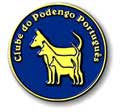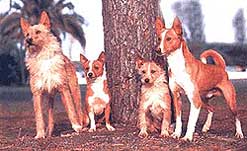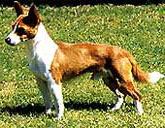

Do you know the Portuguese Podengo ?
 
Do you know the Portuguese Podengo ? |
|
Small
and Medium Podengos wire and smoorth haired
 The
Podengo Portugues is the Portuguese national breed. It is very fast and
agile and extremely durable. Podengos exists in three sizes, small, medium
and large. Each has two hair types – smooth haired and wire haired
- for a total of six varieties. The Podengo Português Grande (big)
height: 55-70cm; the Podengo Portugues Medio (medium); Height: 39-54cm,
weight: 16-20kg; and the Podengo Portugues Pequeno (small) height: 20-30
cm, weight: 4-5 kg The
Podengo Portugues is the Portuguese national breed. It is very fast and
agile and extremely durable. Podengos exists in three sizes, small, medium
and large. Each has two hair types – smooth haired and wire haired
- for a total of six varieties. The Podengo Português Grande (big)
height: 55-70cm; the Podengo Portugues Medio (medium); Height: 39-54cm,
weight: 16-20kg; and the Podengo Portugues Pequeno (small) height: 20-30
cm, weight: 4-5 kg
The Podengo Pequeno (small) height at the shoulder is only 20-30cm which makes him a very handy dog, and yet he is a hardy hunter. This smaller variation of the Podengo Portugues Medio (medium) was breed for hunting. It chases the rabbits out of the tiny rock ledges, and the Podengo Medio would follows them on the flat ground. The smaller Podengo is a variation of the medium sized Podengo but without losing any of its other characteristics. Not much attention was paid to colour or tone of coat. The Podengo may be uni-coloured with occasional white markings, and his colour can vary from a rich red to a light sandy colour or even black. His coat may be short and shiny or longer and rough. Small
Smooth Podengo hunting
Large Wire Podengo  Historically
speaking, the two above mentioned forms of the Podengo are the smaller
types
of the original greyhoundlike Podengo Portugues Grande (Large) which has
sadly become very rare nowadays. The breed goes back as early as the ancient
times. The Pequeno was originally used for catching rats and other small
animals. Later he was used in combination with the medium. Even though
the Pequeno is still being used for hunting, it also has been regarded
as a household pet for as long as 3 centuries. Historically
speaking, the two above mentioned forms of the Podengo are the smaller
types
of the original greyhoundlike Podengo Portugues Grande (Large) which has
sadly become very rare nowadays. The breed goes back as early as the ancient
times. The Pequeno was originally used for catching rats and other small
animals. Later he was used in combination with the medium. Even though
the Pequeno is still being used for hunting, it also has been regarded
as a household pet for as long as 3 centuries.
The Portuguese Podengo to
this day maintains the characteristics of its early ancestors. The selection
of the breed has been made naturally thanks to the absence of human intervention.
It is a natural breed adapted to the environment and hunter functionality.
The designation of Primitive Breed is recognized by the Federation Cinológique
International (FCI) in the 5th group of "Dogs from Spitz type and Primitive
type."
Origin Of the several theories regarding the origin of the Podengo, the most probable to defend is that it, along with other similar breeds of the Mediterranean, descends from the Pharaoh Hound of high old Egypt. It appears to be one of the first differentiated breeds made by the functionality. This type of dog dispersed from Asia Minor (original area of the Phoenicians in 700 b.C.) to the north of Africa and the Mediterranean coast. The Phoenicians introduced the breed to Portugal and all the Mediterranean region.
Egyptian pyramid inscription
Geographical distribution Medium
Smooth-haired
 While
today we find Podengos in the whole national territory, their number is
greatest in High Alentejo, Estremadura and in the area north of the Douro
River. This geographical distribution appears to be the result of incursions
of merchants along the rivers Douro and Tejo. While
today we find Podengos in the whole national territory, their number is
greatest in High Alentejo, Estremadura and in the area north of the Douro
River. This geographical distribution appears to be the result of incursions
of merchants along the rivers Douro and Tejo.
The small Podengo (Podengo
Pequeno) is more likely to be found in the center of the country along
the Tejo River and in the high Alentejo. The medium Podengo (Podengo Medio)
can be found in larger numbers in the north along the Douro River and in
the center along the Tejo. The large Podengo (Podengo Grande) is found
most often in Alentejo near the border, given its exclusive use in the
thick hunt. In the north one finds more smooth-haired Podengos, and in
south, more wire-haired. Contrary to what one would think, the smooth-haired
dogs are more adapted to a rainy climate, because they dry quickly, while
the wire-haired ones need a drier climate, so as not to accumulate water
inside the hair. Hence, the smooth-haired avoids pneumonia and the wire-haired
is naturally protected against excessive sun and heat.
Functionality To this day, the Podengo
has retained his innate aptitude for hunting.
Small
smooth-haired
 The
Small Podengo has been known since the XV century. It was used initially
to hunt mice, controlling the vermin in the houses, barns and even in the
caravels - which is why it has traveled the world! The
Small Podengo has been known since the XV century. It was used initially
to hunt mice, controlling the vermin in the houses, barns and even in the
caravels - which is why it has traveled the world!
The Podengo Pequeno has a special aptitude for hunting under the soil, pursuing badgers, foxes and bag-tails. It was used to enter in the burrows and frighten the quarry, or to kill them directly. That's why it is courageous, smart and lively. Characteristics that we see to this day. But above all, the Podengo is a fearsome rabbit hunter, often used in impenetrable areas, sneaking out from among vegetation and rifts in the rocks. It is known as a "last-resource," exploring where other dogs won't go. The Podengo Pequeno is today used as a companion dog, with excellent results, thanks to his obedient character and affectionate nature. The Podengo maintains a great resistance to diseases or genetic defects and demands very little maintenance. The hair has only one layer and presents obvious advantages during shedding. The breed has a great variety of colors and satisfies different tastes. Because of its size, health, coat and personality, the Podengo Pequeno adapts easily to apartments and to the city as well as country living. This is a distinct advantage when compared to the more traditional companion dogs. Medium
smooth
Large
Smooth-haired
 The
Large Podengo (Podengo Grande) is used to hunt big animals, like the
boar. To this day it continues to hunt in this manner, although it has
suffered strong decreases since the 1970s due to the agricultural and forest
policies of Portugal. Currently, we are seeing a resurgence of the Podengo
Grande, in the two varieties, protected by two breeders who saved the Grande
from extinction. It works in packs and follows tracks, being considered
an excellent dog in the thick hunt, at times sacrificing of its own life.
The Podengo Grande is most often seen in Alentejo near the border, perfectly
adapted to the dry and hot climate of the South. The
Large Podengo (Podengo Grande) is used to hunt big animals, like the
boar. To this day it continues to hunt in this manner, although it has
suffered strong decreases since the 1970s due to the agricultural and forest
policies of Portugal. Currently, we are seeing a resurgence of the Podengo
Grande, in the two varieties, protected by two breeders who saved the Grande
from extinction. It works in packs and follows tracks, being considered
an excellent dog in the thick hunt, at times sacrificing of its own life.
The Podengo Grande is most often seen in Alentejo near the border, perfectly
adapted to the dry and hot climate of the South.
Evolution Medium
Wire-haired
|